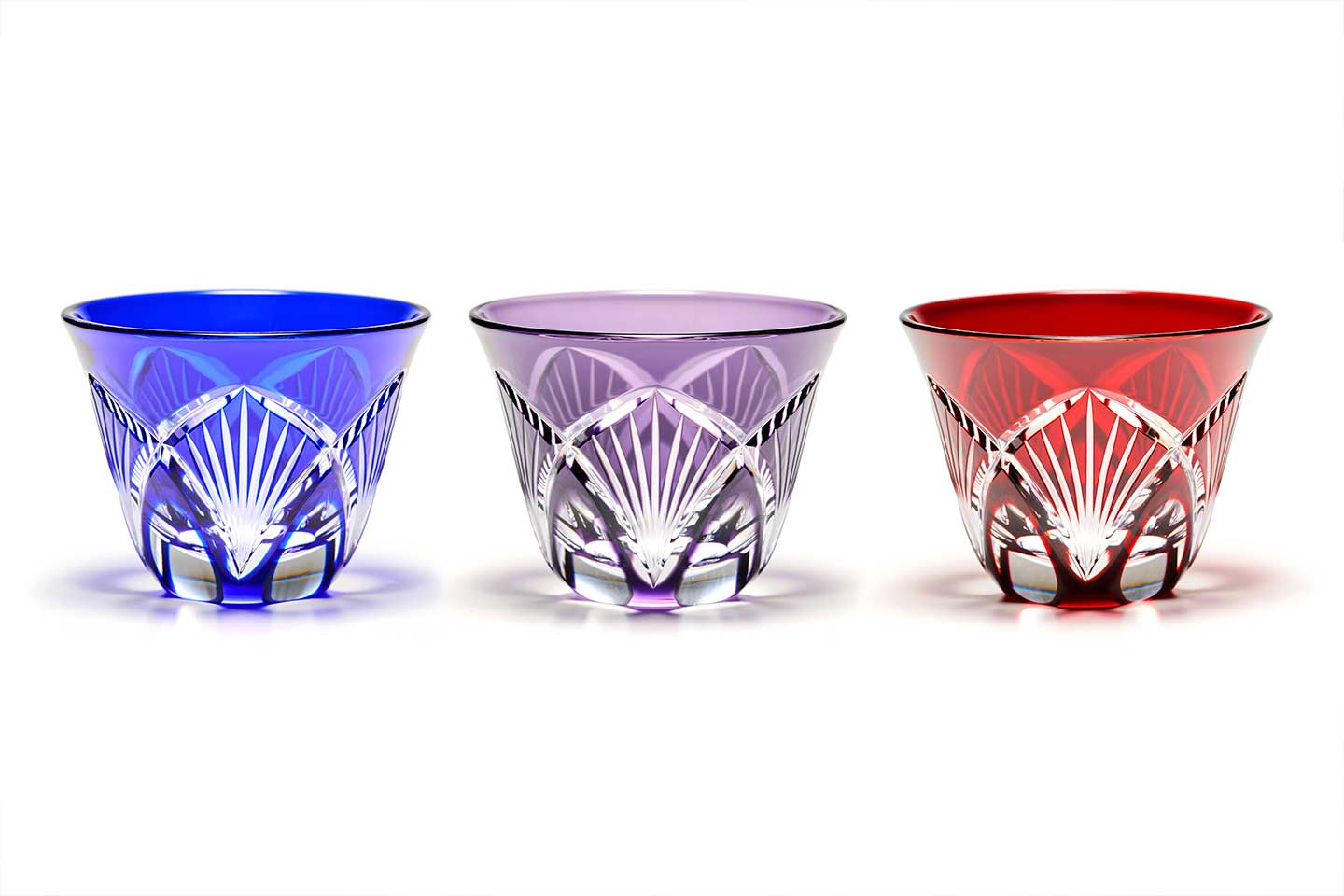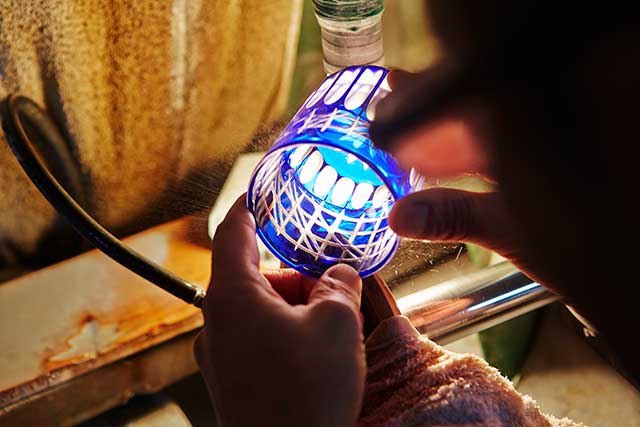
Edo Kiriko is a traditional kind of cut glassware first produced in Edo (modern-day Tokyo) in the 1830s. Though inspired by glassware imported from Europe, it developed a uniquely home-grown tradition with its own tools, techniques, and aesthetics.
-
01
A Brief History of Glass in Japan
Glass was known and prized in Japan since ancient times. The imperial Shosoin Repository contains what appears to be Sasanian glassware brought to Japan more than a thousand years ago, while archaeologists have found comma-shaped magatama beads made of glass in sites dated to the Yayoi Period (300 BCE–300 CE). However, the roots of Edo Kiriko lie in the glassware brought to Japan by European missionaries and merchants starting in the sixteenth century. This glass became known as bidoro, from the Portuguese vidro (glass). Later, cut glass in particular became known as giyaman, from Dutch diamant (diamond), a reference to its sparkling facets.
![Image courtesy of Photo Edo Kiriko Cooperative Association]()
Image courtesy of Photo Edo Kiriko Cooperative Association
Although the shogunate soon restricted the influx of goods and ideas from the outside world, by the early seventeenth century determined Japanese artisans had learned the techniques of glassmaking—from Chinese rather than European sources, some historians argue. In any case, glassmakers in Nagasaki were soon producing sake bottles, cups, and other glassware, and the techniques then spread east to other urban centers like Osaka and Edo. This glassware is now sometimes called wa-garasu (Japanese glass) to distinguish it from the pieces that were also being imported at the same time.
-
02
The First Edo Kiriko
Before long, wa-gaurasu was stable and thick-walled enough to be cut in the same way as giyaman. According to tradition, the first Edo Kiriko was made in 1834 by Kyubei Kagaya, a glass merchant in Denma-cho (just northeast of Shinbashi) who dealt in Japanese and imported bidoro. By this time, European artisans used wheels to make cut glassware, but Kyubei developed his own technique using a small rod dipped in emery and water to cut geometric patterns into the surface of the glass. These patterns were then further smoothed, buffed, and polished for the desired giyaman gleam.
Traditional Edo Kiriko patterns tend to feature countless straight lines that overlap and intersect with satisfying precision. Popular patterns include “Palisade” (yarai), “Hemp leaves” (asa no ha), and “Fish scales” (nanako). Many were adopted directly from European models, particularly cut glassware from England and Ireland.
-
03
Edo Kiriko and Satsuma Kiriko
Edo Kiriko was not the only tradition of kiriko (literally “cut glass”) in nineteenth-century Japan. In 1851, Nariakira Shimazu, 28th daimyo of Satsuma Domain (modern-day Kagoshima Prefecture), sponsored the founding of a “Satsuma Kiriko” workshop.
![Satsuma Kiriko]()
Satsuma Kiriko
Satsuma Kiriko was known for its use of thicker, more expensive glass with red or blue overlays, while Edo Kiriko used clear or only faintly tinted glass, creating the dazzling giyaman effect through form alone. This may be partly because Edo Kiriko was made by independent artisans with no official support from the authorities, but it has also been interpreted as expressing a preference for understated, even nonchalant elegance in Edo. (That said, when Satsuma Kiriko production ended in the 1870s, some of its artisans moved to the eastern capital, and a strain of Satsuma aesthetics entered the Edo Kiriko mainstream.)
-
04
Edo Kiriko Modernizes
The next milestone for Edo Kiriko came in 1873, when the new Meiji government founded a Western-style glassworks in Shinagawa as part of its efforts to encourage new export industries in Japan. At first the glassworks focused mostly on industrial output like glass panes, but in 1881 a British cut glass expert named Emmanuel Hauptmann was invited to Japan to teach Japanese artisans the latest European techniques. Traditional patterns and attention to detail were preserved, but innovations like the wheel were adopted. With colored overlay glass more readily available and demand diversifying, Edo Kiriko artisans began to experiment with color as well.
![Examples of Edo Kiriko with Modern Design
Image courtesy of Photo Edo Kiriko Cooperative Association]()
Examples of Edo Kiriko with Modern Design Image courtesy of Photo Edo Kiriko Cooperative Association
The Edo Kiriko tradition was upheld by generations of artisans over the twentieth century, reflecting aesthetic trends like like “Taisho Romance” and “Showa Modern” while staying true to its roots. In 1985, Edo Kiriko was recognized as a traditional craft of Tokyo, and in 2002 it was recognized as a traditional craft of Japan.
-
05
Edo Kiriko Today
Edo Kiriko remains a living tradition and there are plenty of stores and museums displaying its wares. A few are listed below.
![Image courtesy of Photo Edo Kiriko Cooperative Association]()
Image courtesy of Photo Edo Kiriko Cooperative Association
Shimizu Glass
Naojiro Shimizu, founder of Shimizu Glass, learned his trade from one of Hauptmann’s students, Jinnosuke Imamura. In 1947, the company joined forces with Hoya Glass (now HOYA Corporation) to produce cut glass tableware; today, Shimizu Glass is exploring new fields like architecture and accessories. 2023 marks the company’s centennial. Its products are available at department stores and other retailers.
Website
https://shimizuglass.com/aboutus/Kagami Crystal
Kagami Crystal was founded in 1934 as the first crystal glass factory in Japan. Today, its glassware is used by the Imperial Household and Japanese embassies overseas. Its workshop is now located in Ibaraki, but it maintains stores in Ginza and the Palace Hotel.
Website
https://www.kagami.jp/english/Sumida Edo Kiriko Museum
The Sumida Edo Kiriko Museum, located in Sumida, Tokyo, has a collection of over 300 pieces of Edo Kiriko produced by Hirota Glass over its history of roughly a century. Visitors can also watch artisans create new pieces, or even try making their own pieces in hands-on workshops. Souvenirs can be found in the gift shop.
Tripadvisor
https://www.tripadvisor.com/Attraction_Review-g1066459-d10147569-Reviews-Sumida_Edokirikokan-Sumida_Tokyo_Tokyo_Prefecture_Kanto.html- カガミクリスタル(株)
-
-
- 茨城県龍ケ崎市向陽台4丁目5
-
-
-
- 0297647111
-
View All
- Sumida Edo Kiriko Museum
-
3.0
11 Reviews -
-
- Tokyo Sumida-ku Taihei 2-10-9
-
-
-
- 0336234148
-
-
-
- 10:00-17:00
-
View All





 Go here
Go here





